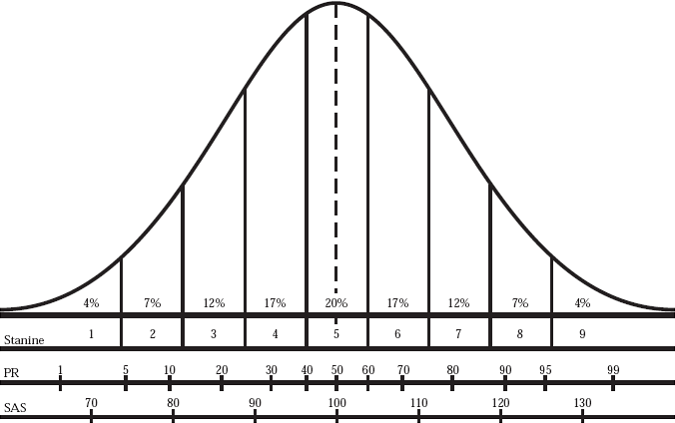Types of Scores
Raw Score
The number of correct answers that a student marks on the answer document is called the raw score.
The CogAT Norms and Score Conversions Guide provides tables for converting the raw score on each battery to a universal scale score.
Universal Scale Score (USS)
The first step in developing norms for CogAT was to construct a universal scale score. The universal scale score is a developmental scale score that is used as the entry for all of the age and grade norms tables for CogAT. The USS provides a continuous growth scale of cognitive development from kindergarten through grade 12.
The CogAT Norms and Score Conversions Guide provides tables for converting the USS on each battery to standard age scores, percentile ranks by age and by grade, and stanines by age and by grade. The guide also provides instructions on how to manually calculate a composite or total score for any two or for all three batteries. Tables are provided in the CogAT Norms and Score Conversions Guide for converting these USS composites to standard age score composites, percentile rank composites (by age or by grade), and stanine composites (by age or by grade) to the guide that appears in the Print Friendly Reference Materials Section.
Standard Age Score (SAS)
The SAS scale is a normalized standard score scale for each battery and composite. The SAS has a mean of 100 and a standard deviation of 16. For example, students who have an SAS of 100 on the Verbal Battery have a rate and level of development of verbal reasoning skills that is typical of their age group. A student who has an SAS of 125 on the Verbal Battery has a faster rate and a higher level of development of verbal reasoning skills than the typical student in the same age group.
The SAS allows you to compare the rate and level of cognitive development of an individual with other students in the same age group. The SAS scale provides fine discriminations among high- and low-scoring students. For this reason, the SAS is useful in determining eligibility for all types of educational programs where maximum discriminations among students at the highest or lowest extremes of the score range are needed.
Percentile Rank (PR)
A percentile rank indicates the percentage of students in the same age or grade group whose scores fall at or below the score obtained by a particular student.
For example, if a fifth grade student obtains a grade PR of 90 on the Quantitative Battery, it means that 90 percent of the fifth grade students in the standardization sample received scores that were the same as or lower than the score obtained by this particular student. For CogAT, percentile ranks are provided for both age and grade groups. A PR of 50 is considered average for an age or grade group.
The meaning of a percentile rank is easy to explain, making percentile ranks useful for reporting results to parents and students, particularly middle school and secondary school students. The major disadvantage of percentile ranks is that a percentile scale has unequal units that can lead a user to misinterpret the test results. For example, the difference of 5 percentile points between a student who has a grade PR of 50 on the Quantitative Battery and one who has a PR of 55 is insignificant. The two students should be considered to have the same level of cognitive development in quantitative reasoning. However, a difference of 5 percentile points between a student who has a grade PR of 90 and one who has a PR of 95 on the Quantitative Battery is very significant. The student with the higher PR should be judged to have a higher level of quantitative reasoning skills than the one with the lower PR.
Stanine (S)
The stanine scale is a normalized standard score scale consisting of nine broad levels designated by the numbers 1 through 9. Stanines are provided for both age and grade groups.
Stanines, which are similar to percentile ranks, are relatively easy to use because they are all one-digit numbers. The major advantage of stanines is that the broad groupings discourage over-interpretation of small, insignificant differences among test scores.
Interchangeability of Normative Scores
Standard age scores, percentile ranks, and stanines reported for each battery and the composite offer three comparable ways of describing an individual’s performance on CogAT. The figure below illustrates the relationship among these scores.
